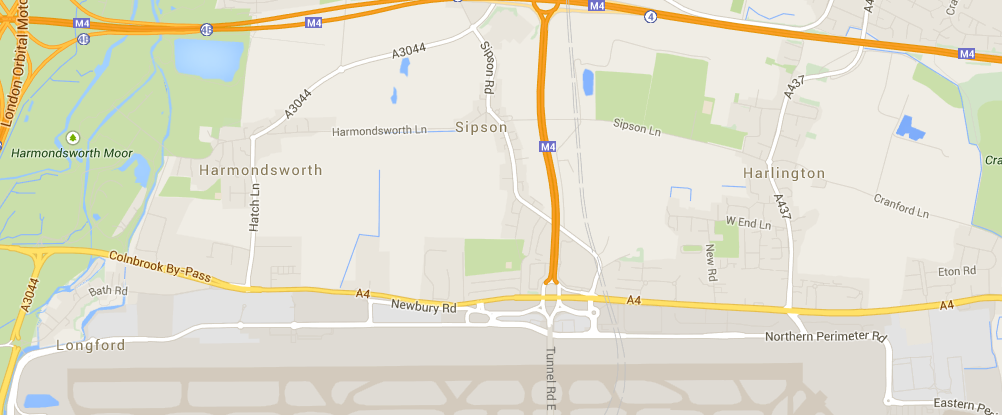The A4 road running along the north border of Heathrow Airport will still exceed EU air pollution limits by 2030 without the addition of a third runway, according to Defra data.
Defra figures reveal that, after the A501 running along the Marylebone Road in London from Paddington to Moorgate, the A4 will be the road with the second highest nitrogen dioxide concentrations in the UK in 2030 if the airport maintains its current capacity of two runways.
Two of the three schemes shortlisted by the Airports Commission would see an expansion of Heathrow Airport
The publication of this NO2 data is a potential blow to Heathrow Airport’s bid to add a third runway, which would likely lead to an increase in passenger numbers and road traffic coming into the airport, with a knock-on effect on local air pollution.
Environmental NGO the Aviation Environment Federation today (February 20) said a third runway at Heathrow “now looks impossible” before 2030 due to the projections of the air quality impacts of expansion.
But, commenting on the Defra figures, a spokesman for Heathrow Airport said: “Heathrow’s expansion will only go ahead within strict environmental limits on noise, local air quality and within the UK’s climate change targets. The expansion of Heathrow relies on managing our environmental responsibilities and working hard on our mitigation strategies.
“Heathrow is committed to playing its part in meeting local air quality limits by incentivising cleaner aircraft and airside vehicles and increasing public transport use by both passengers and employees.”
Data
Released yesterday (February 19) after a Freedom of Information request by campaign group Clean Air in London, the data shows Defra nitrogen dioxide projections for the 50 roads in the UK with the highest NO2 levels up to 2030.
The UK is currently facing legal action from the European Commission regarding its failure to meet EU annual average NO2 limits of 40 ug3 (microgrammes per cubic metre) in London and several other areas of the country.
But, while the data shows the majority of these roads are not expected to comply with the UK and EU annual average NO2 limit by 2030, the figures also reveal considerable reductions are expected on all of the top 50 roads, including the A501.
While average annual NO2 levels on the Heathrow road were monitored as high as 117 ug3 (microgammes per cubic metre) in 2013, this is projected to fall to 96 ug3 this year.
And, by 2030, Defra projects a reduction of NO2 on parts of the A501 to around 48 ug3 – much closer to the national and EU annual average NO2 limit of 40 ug3.
Other roads projected to have the highest NO2 levels in the UK by 2030 include parts of the the A503 (including Seven Sisters Road), A4202 (Park Lane), A102 (Clapton) and the A13 linking London to south Essex.
Outside London, the data reveals that high NO2 levels are forecast for 2030 in breach of EU limits on parts of Birmingham’s A4400 Inner Ring Road and the A40 road running from London to the Welsh coast.
Criticism
The independent Airports Commission, which is currently considering consultation responses ahead of making its final recommendations this summer, conceded in its November 2014 that it had yet to complete its full detailed modelling of the air quality impacts of each of the three UK airport capacity expansion options.
This prompted criticism from environmental and community groups, including UK-based NGO the Aviation Environment Federation (AEF), which earlier this month slammed the “gaping holes” in the Airports Commission’s air quality analysis (see airqualitynews.com story).
And, commenting today (February 20) on the NO2 road data released by Defra, AEF deputy director Cait Hewitt reiterated the NGO’s criticism of the Airports Commission.
And, she said: “Air pollution has always had the potential to be a show stopper in Heathrow’s expansion plans.
“The projections published by the government reveal the extent of the air pollution problem around Heathrow between now and 2030 without even building a third runway. It now looks impossible for a third runway to be operational at Heathrow before 2030 – as the Commission proposes – without breaching legal air quality limits.
“Questions must be asked about the Airports Commission’s decision not to carry out detailed modelling of the air quality impact of a new runway prior to publishing its final consultation.”
http://www.airqualitynews.com/2015/02/20/heathrow-expansion-bid-suffers-air-pollution-blow/

